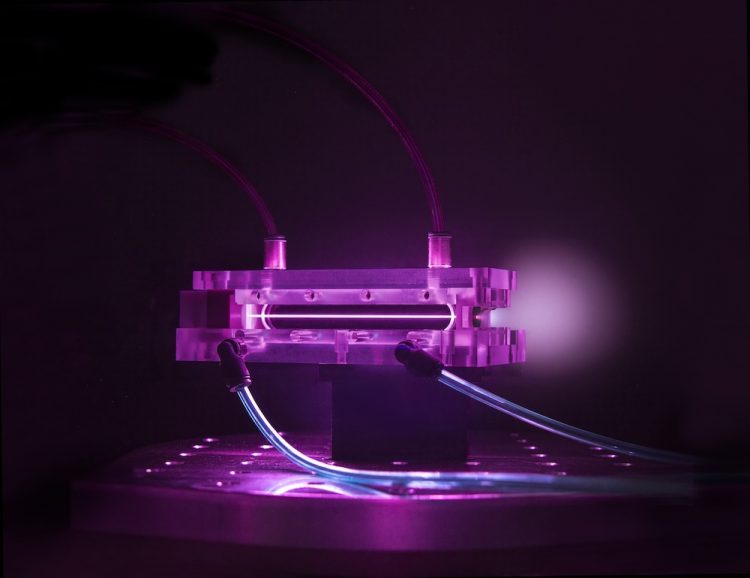World Record for Compact Particle Accelerator

Roy Kaltschmidt A 9 cm-long capillary discharge waveguide used in BELLA experiments to generate multi-GeV electron beams. The plasma plume has been made more prominent with the use of HDR photography.
Using one of the most powerful lasers in the world, researchers have accelerated subatomic particles to the highest energies ever recorded from a compact accelerator.
The team, from the U.S. Department of Energy’s Lawrence Berkeley National Lab (Berkeley Lab), used a specialized petawatt laser and a charged-particle gas called plasma to get the particles up to speed. The setup is known as a laser-plasma accelerator, an emerging class of particle accelerators that physicists believe can shrink traditional, miles-long accelerators to machines that can fit on a table.
The researchers sped up the particles—electrons in this case—inside a nine-centimeter long tube of plasma. The speed corresponded to an energy of 4.25 giga-electron volts. The acceleration over such a short distance corresponds to an energy gradient 1000 times greater than traditional particle accelerators and marks a world record energy for laser-plasma accelerators.
“This result requires exquisite control over the laser and the plasma,” says Dr. Wim Leemans, director of the Accelerator Technology and Applied Physics Division at Berkeley Lab and lead author on the paper. The results appear in the most recent issue of Physical Review Letters.
Traditional particle accelerators, like the Large Hadron Collider at CERN, which is 17 miles in circumference, speed up particles by modulating electric fields inside a metal cavity. It’s a technique that has a limit of about 100 mega-electron volts per meter before the metal breaks down.
Laser-plasma accelerators take a completely different approach. In the case of this experiment, a pulse of laser light is injected into a short and thin straw-like tube that contains plasma. The laser creates a channel through the plasma as well as waves that trap free electrons and accelerate them to high energies. It’s similar to the way that a surfer gains speed when skimming down the face of a wave.
The record-breaking energies were achieved with the help of BELLA (Berkeley Lab Laser Accelerator), one of the most powerful lasers in the world. BELLA, which produces a quadrillion watts of power (a petawatt), began operation just last year.
“It is an extraordinary achievement for Dr. Leemans and his team to produce this record-breaking result in their first operational campaign with BELLA,” says Dr. James Symons, associate laboratory director for Physical Sciences at Berkeley Lab.
In addition to packing a high-powered punch, BELLA is renowned for its precision and control. “We’re forcing this laser beam into a 500 micron hole about 14 meters away, “ Leemans says. “The BELLA laser beam has sufficiently high pointing stability to allow us to use it.” Moreover, Leemans says, the laser pulse, which fires once a second, is stable to within a fraction of a percent. “With a lot of lasers, this never could have happened,” he adds.
At such high energies, the researchers needed to see how various parameters would affect the outcome. So they used computer simulations at the National Energy Research Scientific Computing Center (NERSC) to test the setup before ever turning on a laser. “Small changes in the setup give you big perturbations,” says Eric Esarey, senior science advisor for the Accelerator Technology and Applied Physics Division at Berkeley Lab, who leads the theory effort. “We’re homing in on the regions of operation and the best ways to control the accelerator.”
In order to accelerate electrons to even higher energies—Leemans’ near-term goal is 10 giga-electron volts—the researchers will need to more precisely control the density of the plasma channel through which the laser light flows. In essence, the researchers need to create a tunnel for the light pulse that’s just the right shape to handle more-energetic electrons. Leemans says future work will demonstrate a new technique for plasma-channel shaping.
Lawrence Berkeley National Laboratory addresses the world’s most urgent scientific challenges by advancing sustainable energy, protecting human health, creating new materials, and revealing the origin and fate of the universe. Founded in 1931, Berkeley Lab’s scientific expertise has been recognized with 13 Nobel prizes. The University of California manages Berkeley Lab for the U.S. Department of Energy’s Office of Science. For more, visit http://www.lbl.gov. DOE’s Office of Science is the single largest supporter of basic research in the physical sciences in the United States, and is working to address some of the most pressing challenges of our time. For more information, please visit http://science.energy.gov/
Contact Information
Kate Greene
Science Writer
kgreene@lbl.gov
Phone: 510-486-4404
Media Contact
All latest news from the category: Physics and Astronomy
This area deals with the fundamental laws and building blocks of nature and how they interact, the properties and the behavior of matter, and research into space and time and their structures.
innovations-report provides in-depth reports and articles on subjects such as astrophysics, laser technologies, nuclear, quantum, particle and solid-state physics, nanotechnologies, planetary research and findings (Mars, Venus) and developments related to the Hubble Telescope.
Newest articles

Bringing bio-inspired robots to life
Nebraska researcher Eric Markvicka gets NSF CAREER Award to pursue manufacture of novel materials for soft robotics and stretchable electronics. Engineers are increasingly eager to develop robots that mimic the…

Bella moths use poison to attract mates
Scientists are closer to finding out how. Pyrrolizidine alkaloids are as bitter and toxic as they are hard to pronounce. They’re produced by several different types of plants and are…

AI tool creates ‘synthetic’ images of cells
…for enhanced microscopy analysis. Observing individual cells through microscopes can reveal a range of important cell biological phenomena that frequently play a role in human diseases, but the process of…





















